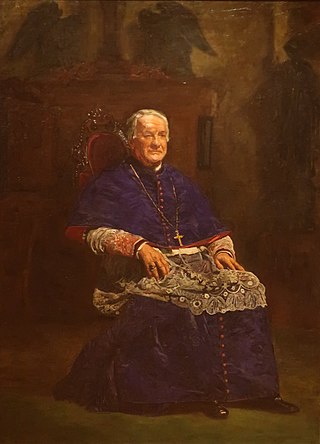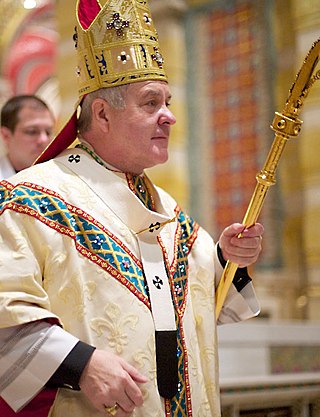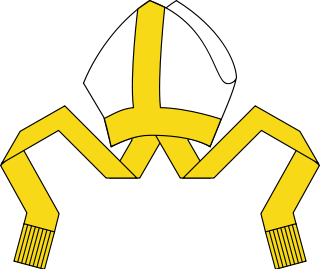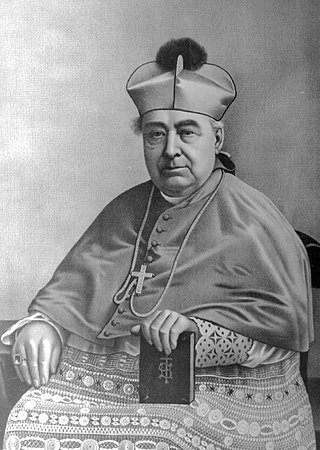Notes and references
Notes
Related Research Articles

The Metropolitan Archdiocese of Philadelphia is a Latin Church ecclesiastical territory, or diocese, of the Catholic Church in southeastern Pennsylvania in the United States.

With 23 percent of the United States' population as of 2018, the Catholic Church is the country's second largest religious grouping, after Protestantism, and the country's largest single church or Christian denomination where Protestantism is divided into separate denominations. In a 2020 Gallup poll, 25% of Americans said they were Catholic. The United States has the fourth largest Catholic population in the world, after Brazil, Mexico, and the Philippines.

The Polish National Catholic Church is an independent Old Catholic church based in the United States and founded by Polish-Americans.

James Frederick Bryan Wood was an American prelate of the Roman Catholic Church. He was the fifth Bishop and first Archbishop of Philadelphia, serving between 1860 and his death in 1883.

Anthony Joseph Bevilacqua was an American cardinal of the Catholic Church. He served as archbishop of the Archdiocese of Philadelphia from 1988 to 2003. Bevilacqua previously served as bishop of the Diocese of Pittsburgh from 1983 to 1987 and as an auxiliary bishop of the Diocese of Brooklyn from 1980 to 1983. He was elevated to the cardinalate in 1991.

Justin Francis Rigali is an American cardinal of the Catholic Church. He was the eighth Archbishop of Philadelphia, having previously served as Archbishop of St. Louis from 1994 to 2003, and was elevated to the cardinalate in 2003. Following a sex abuse probe into the Catholic Church, Cardinal Rigali resigned in 2011.

The Diocese of Raleigh is a Latin Church ecclesiastical territory, or diocese, of the Catholic Church that covers eastern North Carolina in the United States. It is a suffragan diocese in the ecclesiastical province of the metropolitan Archbishop of Atlanta.

The Diocese of Scranton is a Latin Church ecclesiastical jurisdiction, or diocese, of the Catholic Church in northeastern Pennsylvania in the United States. It is a suffragan see of Archdiocese of Philadelphia, established on March 3, 1868.

The Archdiocese of Newark is a Latin Church ecclesiastical jurisdiction, or archdiocese, of the Catholic Church in northeastern New Jersey in the United States.

Robert James Carlson is an American prelate of the Catholic Church. He served as the ninth archbishop of the Roman Catholic Archdiocese of St. Louis in Missouri from 2009 to 2020.

Bishop Franciszek "Francis" Hodur was the founder and first Prime Bishop of the Polish National Catholic Church (PNCC). Ordained by the Roman Catholic church in 1893, Hodur served two parishes in the Scranton diocese before he was excommunicated five years later in 1898 for his release of a National Church program, which called for reformation to canon laws of temporal goods. His excommunication was also a result of his rejection of the dogmas of papal infallibility and supremacy after the Council of Trent. With a congregation of approximately 200 families, he founded the St. Stanislaus Parish in Scranton and celebrated Mass in the Polish vernacular of the congregation, instead of Latin, as was common in the Roman Catholic church. Hodur was consecrated a bishop in 1907 with apostolic succession by the bishops of Old Catholic Church and went on to expand the episcopate of the PNCC to manage diocesan affairs and ordain priests therein. Under Hodur, the church expanded to 245 parishes across the United States and Poland. After his death in 1953, he was succeeded by Leon Growchowski, whom he had consecrated in 1924.

Joseph Francis Martino is an American prelate of the Roman Catholic Church who served as bishop of the Diocese of Scranton in Pennsylvania from 2003 to 2009. He previously served as an auxiliary bishop of the Archdiocese of Philadelphia from 1996 to 2003.

Nicholas Anthony DiMarzio is an American prelate of the Roman Catholic Church who served as bishop of the Diocese of Brooklyn in New York City from 2003 to 2021.

Gerald Frederick Kicanas is an American prelate of the Roman Catholic Church. He served as bishop of the Diocese of Tucson in Arizona from 2002 to 2017. He served as the apostolic administrator of the Diocese of Las Cruces in New Mexico from September 2018 to July 2019.
James Clifford Timlin was an American prelate of the Roman Catholic Church. He served as bishop of the Diocese of Scranton in Pennsylvania from 1984 to 2003. Timlin was accused in a 2018 Pennsylvania grand jury report of covering up sexual abuse crimes by priests in his diocese during his tenure as bishop.

William O'Hara was an Irish-born American prelate of the Catholic Church. He was the first bishop of the Diocese of Scranton in Pennsylvania, serving from 1868 until his death in 1899. He founded St. Thomas College in 1888.

Michael John Hoban was an American prelate of the Roman Catholic Church. He served as bishop of the Diocese of Scranton in Pennsylvania from 1899 until his death in 1926.
Joseph Carroll McCormick was an American prelate of the Roman Catholic Church who served as bishop of the Diocese of Altoona-Johnstown in Pennsylvania (1960–1966) and bishop of the Diocese of Scranton in Pennsylvania (1966–1983).

Ignatius Frederick Horstmann was an American prelate of the Roman Catholic Church. He served as bishop of the Diocese of Cleveland in Ohio from 1892 until his death in 1908.

Mark Edward Brennan is an American prelate of the Roman Catholic Church who is bishop of the Diocese of Wheeling-Charleston in West Virginia. He was installed on August 22, 2019. Brennan previously served as an auxiliary bishop of the Archdiocese of Baltimore in Maryland from 2017 to 2019.
References
- ↑ Boudinhon, Auguste (1913). . In Herbermann, Charles (ed.). Catholic Encyclopedia . New York: Robert Appleton Company.
- ↑ Paulist Fathers. "Our Unique History: The American Parish". Church of Santa Susanna. Home of the American Catholic Church in Rome. Rome, IT: The Church of Santa Susanna. Archived from the original on 2012-12-02. Retrieved 5 December 2012.
- ↑ "American community finds a new home in Rome". National Catholic Reporter. 2017-08-07. Retrieved 2019-12-26.
- ↑ Schroth, Raymond A (1 November 2002). "19th-century lessons in lay governance" (analysis). National Catholic Reporter . Kansas City, MO: National Catholic Reporter Pub. Co. ISSN 0027-8939. OCLC 181819984. Archived from the original on 2011-05-15. Retrieved 3 December 2012.
In the early 19th century, democratic elements in church government emerged from several sources: prelates like Archbishop John Carroll, who insisted that American bishops, including himself, be elected by the priests; civil law which mandated trusteeships; national parishes, particularly German and Polish, who brought over European traditions of the laypeople establishing and directing the parish; visionaries like John England, bishop of Charleston, S.C. (1820-1842), sent from Ireland, who arrived with a diocesan constitution, modeled on the American Constitution. His parishes governed themselves through periodic conventions where elected delegates of clergy and laypeople discussed the region's problems.
- ↑ U.S. Conference of Catholic Bishops. Department of Communications (2008). "Archdiocese of Philadelphia Backgrounder". USCCB Papal Visit Site. Washington, DC: U.S. Conference of Catholic Bishops. Archived from the original on 2013-05-24. Retrieved 3 December 2012.
Key Historical Dates: [...] 1789: Holy Trinity Church is established to serve German-speaking Catholics. It is the first national parish in the United States. [...]
- ↑ U.S. Conference of Catholic Bishops. Department of Communications (2008). "Archdiocese of New York Backgrounder". USCCB Papal Visit Site. Washington, DC: U.S. Conference of Catholic Bishops. Archived from the original on 2013-05-24. Retrieved 3 December 2012.
Key Historical Dates: [...] 1883: Saint Benedict the Moor Church is established as the first national parish for African-American Catholics. [...]
- ↑ Filteau, Jerry (14 September 2009). "Why did the bishop of Scranton, Pa., resign?". National Catholic Reporter . Kansas City, MO: National Catholic Reporter Pub. Co. ISSN 0027-8939. OCLC 181819984. Archived from the original on 2015-04-02. Retrieved 3 December 2012.
The [anonymous] theologian said the religious conservatism and the history of ethnic tensions of Catholics in the Scranton diocese – including the century-old Polish National Catholic church schism from Roman Catholicism, which started with an Irish-American bishop's insensitivity to a Polish national parish in Scranton – are also major factors that have to be taken into account in any assessment of the complex negative response of local priests and laity to Martino's style of governance.
- 1 2 3 Gregory, George (11 November 2010). "Philadelphia Archdiocese Establishes National Parish for Hispanics". AmericanCatholic.org. Cincinnati, OH: Franciscan Media. Catholic News Service. Archived from the original on 2010-11-15. Retrieved 13 December 2016.
- ↑ Pirro, J.F. (January 2012). "St. Rocco Church Welcomes Mexican Immigrants in Avondale". Main Line Today. Newtown Square, Pennsylvania: Today Media. Archived from the original on 13 December 2016. Retrieved 13 December 2016.